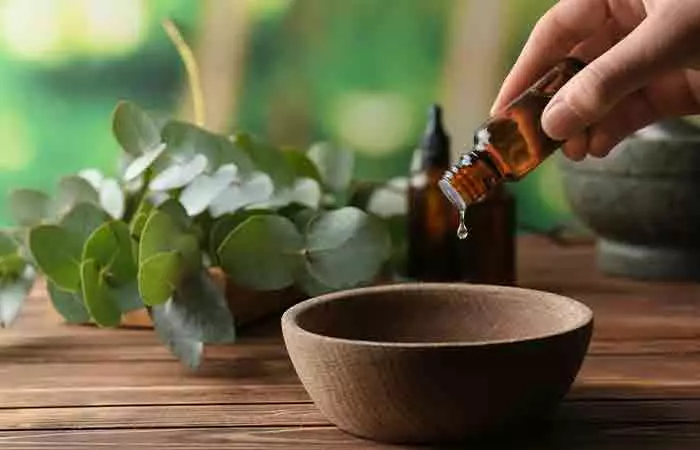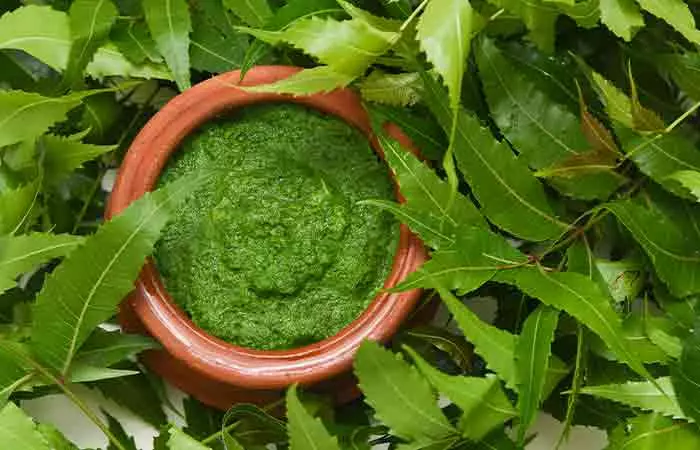How To Get Rid Of Tinea Versicolor Naturally
Home Remedies To Treat Tinea Versicolor
1. Essential Oils
a. Tea Tree Oil
7 drops of tea tree oil 1 teaspoon of coconut oil
You must do this 2 to 3 times daily. Tinea versicolor might result in itchy and discolored skin. The anti-inflammatory properties of tea tree oil can help in relieving the itching, while its antifungal activities eliminate the fungus causing this condition (1).
b. Eucalyptus Oil
6-7 drops of eucalyptus oil 1 teaspoon of any carrier oil (coconut oil, jojoba oil, etc.)
Do this multiple times daily. Eucalyptus oil contains a compound called eugenol, which is popular for its anti-inflammatory and antimicrobial actions. It helps relieve the symptoms of tinea versicolor and can also be used to fight the Malassezia fungus (2).
c. Patchouli Oil
8 drops of patchouli oil 1 teaspoon of coconut oil
You must do this thrice daily. Patchouli oil helps soothe inflamed and itchy skin. It is also a great remedy to fight fungal infections, thanks to its antifungal properties – which also help treat tinea versicolor (3), (4).
2. Baking Soda
1-2 teaspoons of baking soda Water (as required)
You must do this on a daily basis. Fungi cannot survive in an alkaline environment. The pH of your skin is usually acidic. Baking soda makes it alkaline and soothes itching (6).
3. Garlic
Minced garlic Do this twice daily. Garlic is a rich source of a compound called allicin. This organosulfur compound is known for its powerful anti-inflammatory and antimicrobial activities that can be used to treat tinea versicolor and its symptoms (6).
4. Vitamins
Vitamins A, D, and E can help treat tinea versicolor. They regulate your melanin production and promote faster recovery (7), (8). These vitamins are also great antioxidants and exhibit healing properties. These vitamins are available in spinach, turnips, kale, eggs, milk, fish, and broccoli. You can also take supplements to combat vitamin deficiency after consulting a doctor.
5. Yogurt
You Will Need
Plain yogurt (as required) Vitamin D: Oily fish, red meat, liver, fortified foods and juices, and egg yolks. Vitamin E: Nuts, seeds, wheat germ, and plant or vegetable oils.
What You Have To Do
How Often You Should Do This
You must do this 2 to 3 times daily.
Why This Works
Yogurt is rich in probiotics, which display antifungal activities. They can be used to treat the Malassezia fungus that causes tinea versicolor (9).
6. Coconut Oil
Coconut oil (as required) You must do this 2 to 3 times daily. The anti-inflammatory, analgesic, and antifungal activities of coconut oil can aid the treatment of tinea versicolor. The presence of monolaurin makes coconut oil a wonderful remedy (10), (11).
7. Apple Cider Vinegar
1 tablespoon of apple cider vinegar 1 cup of water Cotton pads
Do this 2 to 3 times daily for effective results. The acetic acid in apple cider vinegar exhibits remarkable anti-inflammatory properties, which (along with the antifungal properties) help relieve the inflammation and infection associated with tinea versicolor (12).
8. Aloe Vera
1 tablespoon of aloe vera gel You must do this multiple times daily until you notice a difference. Aloe vera’s healing nature can speed up your recovery. It also has powerful anti-inflammatory properties and acts as an antifungal medication that can help you get rid of tinea versicolor (13), (14).
9. Castor Oil
Castor oil (as required) Apply castor oil multiple times on the affected area daily. The ricinoleic acid (ricinoleate) in castor oil exhibits anti-inflammatory and antimicrobial activities that help treat tinea versicolor (15), (16).
10. Epsom Salt
1 cup of Epsom salt Water
Do this once daily. Epsom salt contains magnesium, which helps reduce inflammation. The topical application of Epsom salt helps in treating the inflammatory symptoms of tinea versicolor (17).
11. Grapefruit Seed Extract
A few teaspoons of grapefruit seed extract Cotton pads
You must do this 2 to 3 times daily. Grapefruit seed extract is a powerful anti-inflammatory and antifungal remedy that can be used to combat the fungus that causes tinea versicolor (18).
12. Neem
A handful of neem leaves Water
You must do this 3 to 4 times daily. Neem is a popular herbal medicine. It helps reduce inflammation in your skin and fights fungal infections with its anti-inflammatory and antifungal properties (19), (20). The topical application of this herb can work wonders in treating tinea versicolor.
13. Turmeric
2 teaspoons of turmeric powder Water (as required)
Do this thrice daily. The main constituent of turmeric is curcumin, which has antifungal as well as anti-inflammatory properties that amazingly work well against tinea versicolor (21), (22). Using turmeric regularly can be one of the best hygiene practices, it helps prevent bacterial infection and reduce skin issues.
14. Candle Bush
Candle bush leaves Olive oil (as required)
You must do this 2 to 3 times daily. Candle bush leaves contain effective antifungal compounds. Which is why they can be effective against tinea versicolor, as per a study published in Ethnopharmacology in 1994 (23).
15. Honey
Organic honey (as required) Do this several times daily. Given the healing, anti-inflammatory, and antifungal properties of honey, it is no surprise that it can effectively treat tinea versicolor and its symptoms (24). These home remedies may help improve the symptoms associated with tinea versicolor. However, learning more about the condition and the causes behind it can help you make an informed decision about managing and treating it. Scroll down to learn more in detail.
What Is Tinea Versicolor?
There is a fungus called Malassezia that lives on the surface of your skin. Although it usually doesn’t cause any health problems, this fungus can sometimes grow out of control and cause changes in the natural color of your skin. As a result, you may develop patches that are lighter or darker than the surrounding skin. This condition is referred to as tinea versicolor. Another term used for this condition is pityriasis versicolor. According to a study published in the Skin Health and Disease journal, the prevalence of tinea versicolor in the US is 0.67%. This prevalence rate was based on the electronic health record data of 251,597 participants, 1698 of which had tinea versicolor. Compared to the white population, Black and Hispanic participants were at a higher risk of the condition. Physically disabled participants were also found to have significantly higher odds of developing tinea versicolor than their able-bodied counterparts. One of the main signs of the onset of this condition is a discolored patch or patches that surface on your skin. These patches occur in various forms. The following section lists the symptoms of tinea versicolor.
Signs And Symptoms Of Tinea Versicolor
The most prominent symptom of tinea versicolor are discolored skin patches that can occur on your arms, chest, neck, or even back. These patches might be:
Discolored as compared to the surrounding skin Red, brown, pink or slightly tanned Itchy, scaly, and dry More evident with tanning Disappear in cooler and less humid weather
Symptoms like skin scaling tend to be more noticeable in humid weather, while discomfort with mild itching is particularly common in warmer climates. The exact cause of this uncontrolled growth of Malassezia fungus is not yet established. However, some factors are known to promote the growth of this fungus and increase the risk of infection. You may try home remedies for fungal skin infections for primary relief, especially if they are caused by Malassezia fungus. Now, let’s take a look at the factors that may increase your risk of developing this infection.
Causes And Risk Factors For Tinea Versicolor
Factors that can promote the growth of Malassezia fungus are:
Hot and/or humid climate Sweating a lot Oily skin Weak immunity Hormonal changes
Some factors can increase your risk of developing this skin condition. They include:
A family history of tinea versicolor Living in a subtropical climate Taking medications that may weaken your immune system Cancer Taking medications that may disrupt your hormonal balance
Tinea versicolor is not physically uncomfortable or contagious, however, it can make one self-conscious if it remains over a period of time. Keep reading to know more.
What Happens If Tinea Versicolor Is Left Untreated?
Tinea versicolor usually does not cause any concerning side effects and there are plenty of treatment options and over-the-counter medications available to help treat it. However, if left untreated, it may continue to persist for years (25). It may also cause lasting skin discoloration in some people. One of the easiest ways to find out if you have developed tinea versicolor is to observe yourself physically and look for discolored patches. Your doctor may also conduct the following tests to check for the onset of tinea versicolor.
How Is Tinea Versicolor Diagnosed?
Tinea versicolor can usually be diagnosed by looking at your skin. However, if such a diagnosis is not possible, your doctor may ask to take the following tests:
A skin scraping test that involves scraping the affected skin and observing it under a microscope for the fungus. Potassium hydroxide (KOH) microscopy, which involves observing scraped skin with a KOH solution under a microscope. Biopsy, which requires the outer layer of your skin to be tested. Wood’s lamp test, which involves the use of a special machine called Wood’s lamp that uses ultraviolet rays to check for the presence of fungus on your skin.
Aaron Kemper, a modern medicine blogger, explained how he struggled with Tinea Versicolor in his childhood. He states, “..Tinea versicolor ended up being much harder to treat than I imagined. From my original dermatology appointment, I had taken an oral antifungal called Ketoconazole and also applied a topical one as well. It didn’t work (i).” If the presence of the fungus is confirmed, you can begin with the treatment almost immediately. The tinea versicolor treatment can also be initiated right at home with the help of some basic home remedies that are listed below. Along with natural remedies, it is also important to consider diet changes for treating tinea versicolor and preventing its recurrence.
Diet Tips
If you are have tinea versicolor, you must pay extra attention to your regular diet. Following are two lists –foods that you must eat more of, and foods that are best avoided when you are suffering from tinea versicolor. Take a look.
Probiotic-rich yogurt Low-carb foods like broccoli, green beans, avocados, etc. Protein-rich foods like fish, meat, eggs, and poultry Garlic
Sugar Alcohol Vinegar Nuts Fruits
You must also make a few lifestyle changes to assist your recovery. This can be done by simply following these prevention tips.
Prevention Tips
Avoid hot and humid climates. Do not tan or expose yourself to the sun too much. Try and sweat minimally. Do not indulge in intense exercises. Take a bath twice a day. Don’t let sweat dry up on your skin. Wipe it with a handkerchief.
Even if you follow the prevention tips, the chances of recurrence of this condition are high. Hence, you must be at your attentive best and avoid all triggers. If you have cosmetic concerns with the appearance of tinea versicolor, consider the OTC medications in the next section.
Over-The-Counter Medications For Tinea Versicolor
For mild cases, dermatologists may typically recommend antifungal medications such as –
Terbinafine Selenium sulfide Miconazole Clotrimazole Products with zinc pyrithione
If the condition gets severe, consult your dermatologist for appropriate treatments. Learn how to treat tinea versicolor effectively. Check out the following video to understand the causes and symptoms of this condition and learn from an expert on how to treat it. What is the best way to treat tinea versicolor? Other than the discussed home remedies, antifungal creams or shampoos are usually effective for treating tinea versicolor. In some cases, a doctor might prescribe oral antifungal medication for more severe infections. Can lifestyle changes help prevent tinea versicolor? Lifestyle changes can help prevent tinea versicolor. Keeping your skin clean and dry, avoiding excessive heat and humidity, and wearing breathable clothing can reduce the risk of developing this condition. How do you get rid of tinea versicolor overnight? Dr. Emmanuel (Michael) R. Loucas, MD, Board-Certified Dermatologist, says, “There is no way to clear it so quickly. The reason the rash presents as white spots is because of the yeast that clocks your pigment cells from making pigment when in the sun. So, we first have to treat the yeast and then have people get some sun on the areas to stimulate their pigment cells. This process can take several weeks.” Should I moisturize tinea versicolor? Dr. Loucas says, “Moisturizing the areas can’t hurt and will help to decrease the flaking often seen. It will treat the actual condition, but can improve its appearance.” Is tinea versicolor the same as vitiligo? No. Vitiligo is a result of dysfunctionality of the cells that produce melanin, while tinea versicolor is a skin condition caused by a yeast fungus called Malassezia. How long does tinea versicolor last? In about two weeks, the physical symptoms like scaly and dry skin will be resolved. However, it may take about 6 to 12 months for your normal skin color to be restored. Which is the best soap for tinea versicolor? Antifungal soaps (like Naturasil Tinea Versicolor) are often recommended as one of the treatment options of tinea versicolor. Zinc pyrithione is another soap used for treating tinea versicolor. Which antifungal cream is best for tinea versicolor? Topical creams containing antifungal ingredients like clotrimazole, miconazole, selenium sulfide, and terbinafine are recommended for the treatment of tinea versicolor. You can also use any of the above remedies if you are looking for natural alternatives. Does tinea versicolor itch? Although the discolored skin patches are not contagious or painful, they may become scaly and itchy. Which area of your body is most affected by tinea versicolor? Tinea versicolor can affect any part of your body, but it is most likely to affect your neck, chest, back, and arms. Can hot showers cause tinea versicolor? Yes. While regular washing or showering helps remove fungi and dead skin cells, hot showers favor fungal growth. How do you know if tinea versicolor is healing? If you observe the discoloration of your skin fade away, it means tinea versicolor is healing. Is Vaseline good for tinea versicolor? Anecdotal evidence suggests that Vaseline is good for tinea versicolor. However, limited research is available in this regard. Is tinea versicolor an autoimmune disease? No. Tinea versicolor is not an autoimmune disease.
Illustration: How To Get Rid Of Tinea Versicolor - 15 Home Remedies To Try













